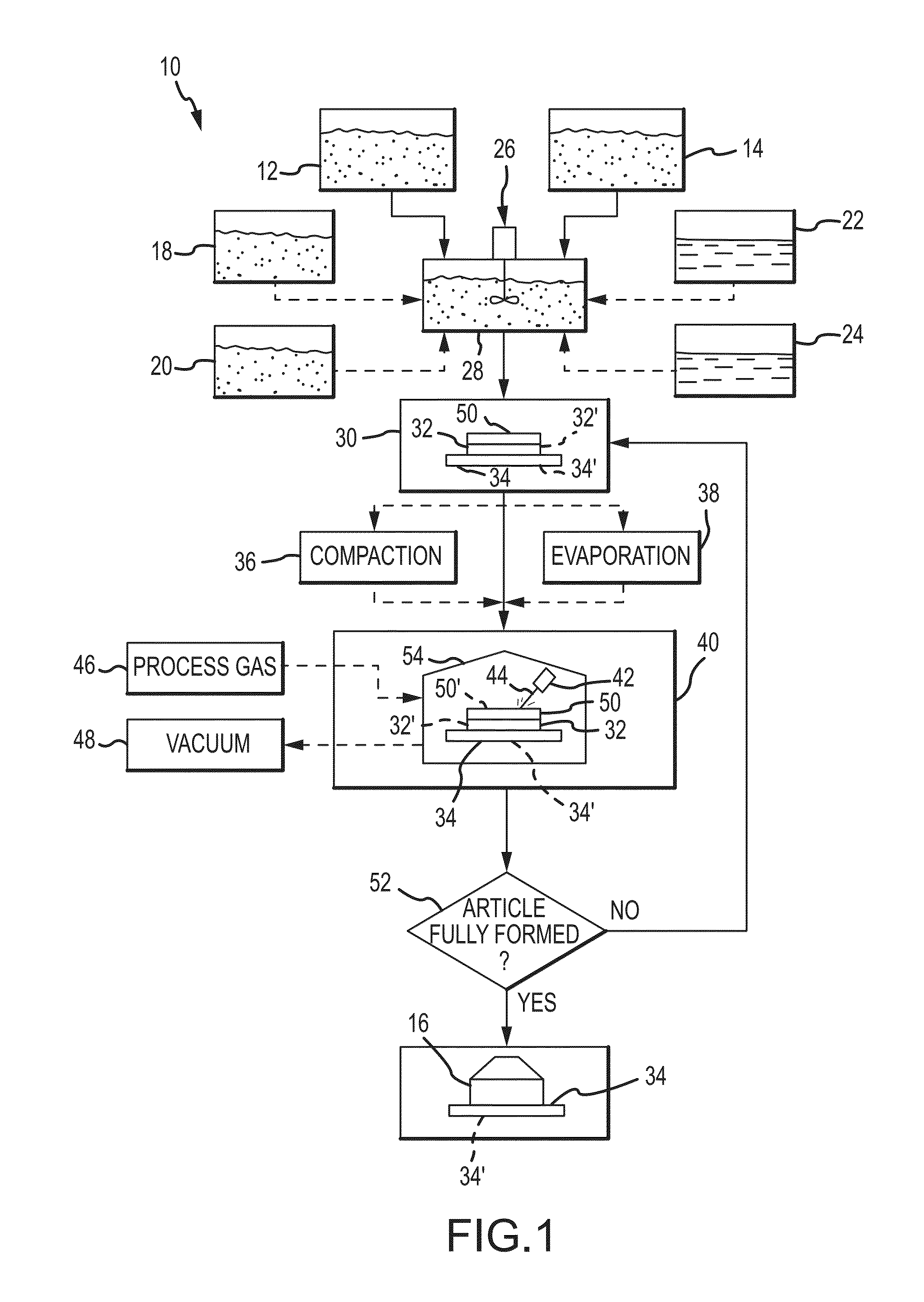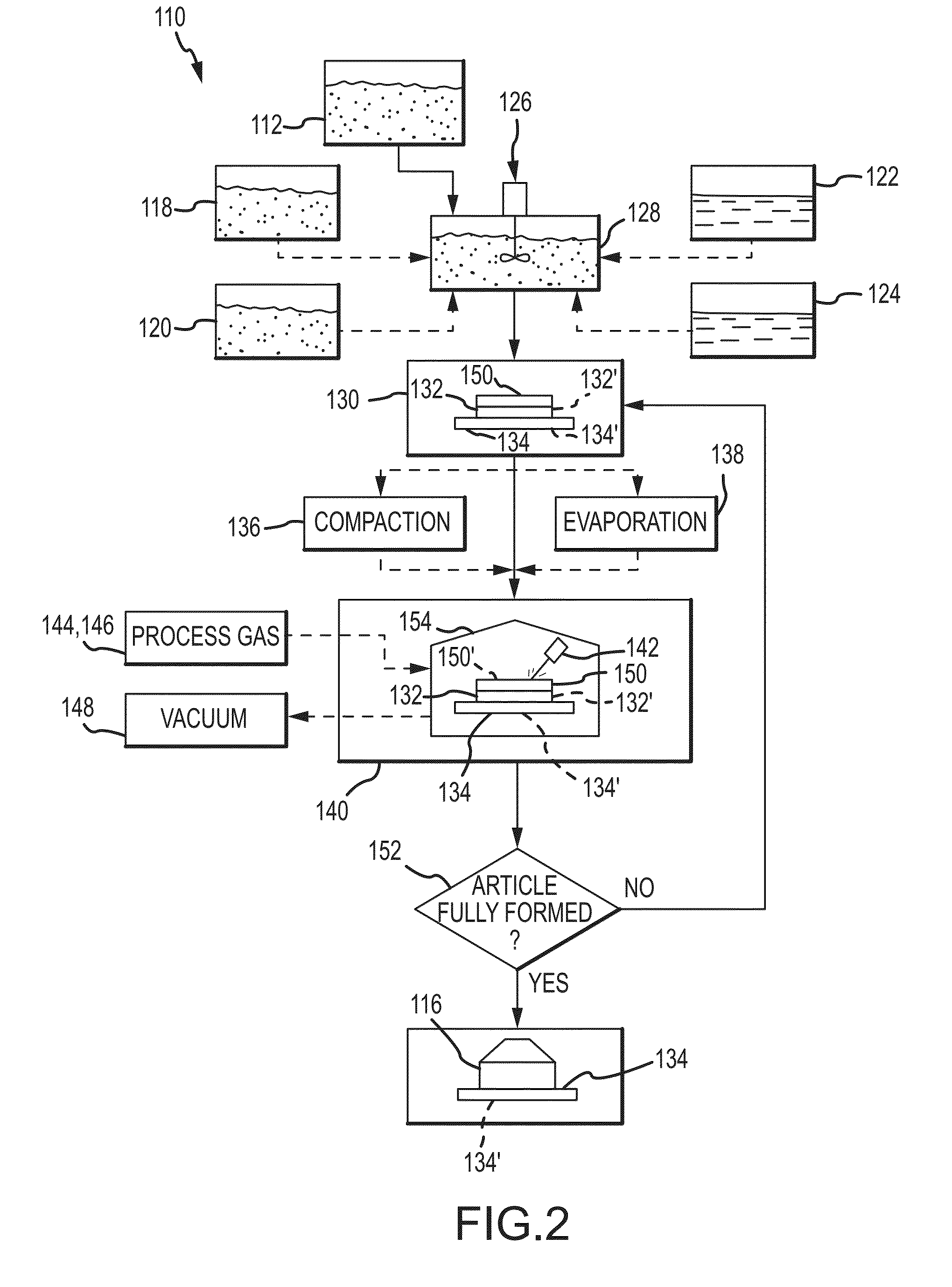Reactive additive manufacturing
a technology of additive manufacturing and manufacturing process, applied in the field of additive manufacturing general, can solve the problems of limiting such processes, restricting production speed, and increasing the cost of equipment needed to produce objects, and achieves high energy input, high quality parts, and high strength.
- Summary
- Abstract
- Description
- Claims
- Application Information
AI Technical Summary
Benefits of technology
Problems solved by technology
Method used
Image
Examples
example 1
TiB2—TiC-85Al
[0073]An exothermically reactive mixture containing by weight 76.8% aluminum, 16.8% titanium, and 6.5% boron carbide powders was designed to produce a product with an aluminum matrix and ceramic reinforcing phases comprising by volume 85% aluminum, 10.75% titanium diboride, and 4.25% titanium carbide. The mixture has a calculated adiabatic reaction temperature of 933 Kelvin. A mixture with a total weight of 4000 g. was prepared by weighing the constituent powders according to the percentages above. The powders were mixed using a motorized tumbler. The mixed powders were then placed in the dispenser tray of an EOS M290 direct metal laser sintering (DMLS) machine, available from EOS of North America, Inc. of Novi, Mich. (US).
[0074]Three dimensional models of articles for manufacture were designed using a computer aided design (CAD) software program and digitally sliced into layers corresponding to the thickness of one layer of powder to be spread. The digital information ...
example 2
(Ti—V)B2, C-85Al—Mg Matrix
[0078]An exothermically reactive mixture containing by weight 75.19% aluminum / 4.5% magnesium alloy powder, 18.23% titanium / 6% aluminum / 4% vanadium powder, and 6.58% boron carbide powder was designed to produce a product with an aluminum / 4.5% magnesium matrix comprising by volume 85% and ceramic reinforcing phases comprising by volume 15% titanium and vanadium diborides and carbides. The mixture has a calculated adiabatic reaction temperature of 933 Kelvin. A mixture with a total weight of 4000 g. was prepared by weighing the constituent powders according to the percentages above. The powders were mixed using a motorized tumbler. The mixed powders were then placed in the dispenser tray of the EOS M290 direct metal laser sintering (DMLS) machine.
[0079]Three dimensional models of articles for manufacture were designed using a computer aided design (CAD) software program and digitally sliced into layers corresponding to the thickness of one layer of powder to b...
example 3
NiTi
[0082]An exothermically reactive mixture containing by weight 55.5% nickel and 44.5% titanium was designed to produce a product comprised of intermetallic nickel-titanium shape memory alloy. The mixture has a calculated adiabatic reaction temperature of 1438 Kelvin. A mixture with a total weight of 2500 g. was prepared by weighing the constituent powders according to the percentages above. The powders were mixed using a motorized tumbler. The mixed powders were then placed in the dispenser tray of the EOS M290 direct metal laser sintering (DMLS) machine.
[0083]Three dimensional models of articles for manufacture were designed using a computer aided design (CAD) software program and digitally sliced into layers corresponding to the thickness of one layer of powder that will be spread. The digital information was sent to the EOS M290 DMLS machine.
[0084]The processing chamber of the DMLS machine was flooded with argon gas and a layer of the powder mixture having a thickness of about...
PUM
| Property | Measurement | Unit |
|---|---|---|
| diameter | aaaaa | aaaaa |
| particle sizes | aaaaa | aaaaa |
| temperature | aaaaa | aaaaa |
Abstract
Description
Claims
Application Information
 Login to View More
Login to View More - R&D
- Intellectual Property
- Life Sciences
- Materials
- Tech Scout
- Unparalleled Data Quality
- Higher Quality Content
- 60% Fewer Hallucinations
Browse by: Latest US Patents, China's latest patents, Technical Efficacy Thesaurus, Application Domain, Technology Topic, Popular Technical Reports.
© 2025 PatSnap. All rights reserved.Legal|Privacy policy|Modern Slavery Act Transparency Statement|Sitemap|About US| Contact US: help@patsnap.com



